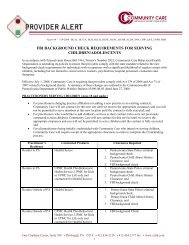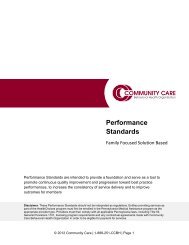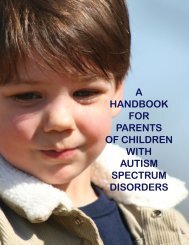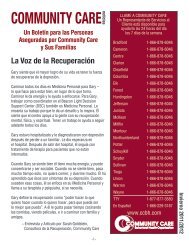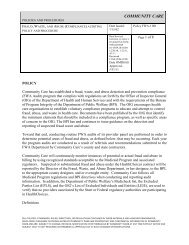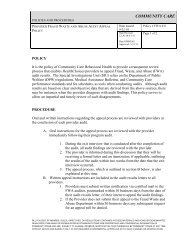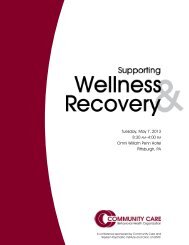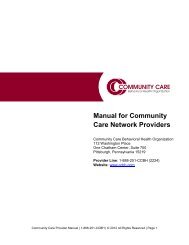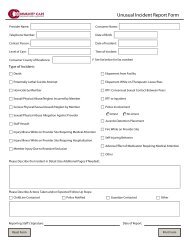a handbook for parents of children with autism spectrum disorders
a handbook for parents of children with autism spectrum disorders
a handbook for parents of children with autism spectrum disorders
You also want an ePaper? Increase the reach of your titles
YUMPU automatically turns print PDFs into web optimized ePapers that Google loves.
ANSWERS TO YOUR QUESTIONS<br />
How do I get BHRS or wraparound services?<br />
In order to obtain BHRS, you can have your child evaluated at one <strong>of</strong> the<br />
mental health providers in the county (See Appendix I). An evaluation will be<br />
<strong>of</strong>fered <strong>with</strong>in seven days <strong>of</strong> the initial phone call.<br />
What will happen at an evaluation <strong>for</strong> BHRS?<br />
There isn’t one<br />
specific cause <strong>of</strong><br />
Autism. Research<br />
has focused on<br />
whether chemical<br />
imbalances,<br />
differences in the<br />
brain, genetics, or<br />
problems <strong>with</strong> the<br />
immune system play<br />
a role in causing the<br />
disorder.<br />
Be<strong>for</strong>e the evaluation, a master’s-level clinician will ask you questions about<br />
your child’s developmental history and current and past behaviors, including<br />
definitions <strong>of</strong> the behaviors, the frequency and intensity <strong>of</strong> the behaviors, past<br />
medical history review <strong>of</strong> strengths, current school or preschool placement if<br />
relevant, drug and alcohol history if relevant, family psychiatric history, past<br />
treatment, and medical history. You should bring as much in<strong>for</strong>mation as<br />
possible to this appointment.<br />
The clinician will make a level-<strong>of</strong>-care determination <strong>for</strong> BHRS and/or another<br />
level <strong>of</strong> care that will address your child’s needs.<br />
What is a Functional Behavioral Analysis and should one be completed<br />
<strong>for</strong> my son/daughter?<br />
A Functional Behavioral Analysis (FBA) is an attempt to look beyond the<br />
obvious interpretation <strong>of</strong> behavior and determine the specific function that it<br />
may be serving <strong>for</strong> a child. Truly understanding why a child behaves a certain<br />
way is the first and best step to developing strategies to stop the behavior.<br />
An FBA includes the gathering <strong>of</strong> in<strong>for</strong>mation through interviews <strong>of</strong> caregivers<br />
as well as direct observation and data analysis <strong>of</strong> when the behaviors occur.<br />
During the FBA process, the family, school staff, and a BHRS BSC (trained<br />
in the FBA process) will observe your child in several <strong>of</strong> the settings in<br />
which the behavior occurs. The BSC notes what comes be<strong>for</strong>e the behavior<br />
(also called the “antecedent”), the behavior, and what happens after the<br />
behavior (also called the “consequence”) over a period <strong>of</strong> time. The BSC also<br />
interviews teachers, <strong>parents</strong>, and other caregivers who work <strong>with</strong> the child<br />
to evaluate how the child’s diagnosis may affect behavior and manipulate<br />
the environment to see if there is a way to avoid the behavior (<strong>for</strong> example,<br />
providing a child <strong>with</strong> a sensory tool such as a chewy tube to avoid having the<br />
child chew on inedibles in his or her environment). This in<strong>for</strong>mation becomes<br />
the basis <strong>for</strong> a behavior plan. The behavior plan will include specific treatment<br />
interventions to replace destructive, disruptive, or distracting behaviors <strong>with</strong><br />
more socially appropriate, acceptable behaviors.<br />
- Page 12 -



